骨髓间充质干细胞衍生的外泌体 MicroRNA-133a 通过抑制 MAML1 抑制病毒性心肌炎大鼠的心肌纤维化和上皮间质转化
摘要
心肌炎是一种以心肌局部或弥漫性炎症为特征的疾病,未经有效治疗。本研究探讨了骨髓间充质干细胞衍生外泌体(BMSC-Exo)分泌的microRNA-133(miR-133)对病毒性心肌炎(VMC)大鼠心肌纤维化和上皮间质转化(EMT)的调控机制。类主谋 1 (MAML1)。分离培养大鼠骨髓间充质干细胞,鉴定其免疫表型和成骨成脂能力,提取并鉴定BMSC-Exo。通过超速离心获得外泌体,通过透射电子显微镜和蛋白质印迹分析进行鉴定。大鼠注射柯萨奇B3病毒制备VMC模型,同动物实验(NC Exo , Ad-miR-133a Exo , Adas-miR-133a Exo )。进行了体内和体外实验,以确定外泌体 miR-133a 和 MAML1 在炎症、细胞凋亡、EMT、纤维化和细胞活力中的作用。 miR-133a和MAML1之间的靶向关系通过双荧光素酶报告基因检测验证。 BMSC-Exo上调VMC大鼠miR-133a表达,有效改善VMC大鼠心功能和心肌纤维化,增加心肌细胞活力,抑制EMT过程。外泌体中升高的 miR-133a 加强了改善。沉默的 miR-133a 有效地逆转了 BMSC-Exo 对 VMC 大鼠的影响。 miR-133a 靶向 MAML1。抑制 MAML1 可改善 VMC 大鼠的心脏功能和心肌纤维化,并可逆转 miR-133a 沉默的外泌体对 VMC 大鼠的影响。我们的研究表明,升高的外泌体miR-133a通过下调MAML1抑制VMC大鼠心肌纤维化和EMT,从而抑制心肌炎的进展。
介绍
心肌炎被认为是心肌细胞的炎症性疾病[1]。与女性相比,男性明显更熟悉心肌炎 [2]。病毒性心肌炎 (VMC) 是导致年轻人扩张型心肌病 (DCM) 和猝死的主要因素 [3]。心肌炎的临床表现多种多样,从体征不明确的无症状状态到心源性休克和心律失常被病毒和免疫细胞破坏的严重心肌[1]。心肌炎可由多种感染因素诱发,包括病毒、细菌、衣原体、立克次体、真菌和原生动物,以及非感染性诱因。其中,病毒感染是最常见的原因,尤其是儿童[4]。柯萨奇B3病毒(CVB3)作为导致心肌炎最关键的病毒,在VMC的发病过程中可引起氧化应激反应和细胞凋亡,但对VMC的特殊治疗尚未见报道[5]。此外,VMC的发病机制尚不明确,也缺乏确切的临床治疗方法[3]。因此,迫切需要新的靶点来改善疾病的预后。
MicroRNA (miRNA) 是内源性非编码 RNA,可以调节蛋白质编码基因的表达 [6]。 MiR-133a 作为心脏特异性 miRNA 之一,与心脏发育和一些心血管疾病有关,包括心肌梗塞 (MI) [7]。此外,miR-133a 是一种在慢性恰加斯病心肌病中异常表达的基因 [8]。此外,心肌中的 miR-133a 水平与炎症、左心室功能和炎症性心肌病的临床结果有关 [9]。在源自小鼠和人类肥大细胞的外泌体中发现了 MiRNA [10]。大多数细胞种类释放的外泌体、纳米级囊泡存在于不同的生物体液中 [11]。外泌体可以将它们的货物转移到受体细胞,这已被证明可以改变受体细胞的生化成分和信号通路 [12, 13]。有证据表明,改变的外泌体 miRNA 与 CVB3 诱导的心肌炎的发病机制有关 [14]。已经解决了来自缺氧条件的骨髓间充质干细胞的外泌体 miR-125b-5p 减少心肌细胞凋亡并增强缺血性心脏修复 [15]。此外,来自 MSC 的外泌体 miR-25-3p 通过减少心肌细胞凋亡和炎症反应来减轻 MI [16]。有趣的是,外泌体心脏表达的 miR-133a 与心肌肌钙蛋白心肌肌钙蛋白 I 相关 [17]。 Mastermind-like 1 (MAML1) 是我们研究中交叉筛选的 miR-133a 下游基因,据报道其与心肌缺血/再灌注 (I/R) 损伤有关 [18]。此外,最近的一项研究提到MAML1敲低在肝纤维化中具有抗纤维化功能[19]。
在之前的研究的启发下,人们想知道 BMSCs 衍生的外泌体 miR-133a 是否可以介导心肌炎。因此,本研究假设由BMSC衍生的外泌体(BMSC-Exo)穿梭的miR-133通过调节MAML1改善VMC大鼠的心肌纤维化和上皮间质转化(EMT)。
材料和方法
道德批准
该研究得到了浙江大学医学院附属第四医院机构动物护理和使用委员会的许可。动物受到人道对待。
BMSCs的隔离
实验动物为成熟的无特定病原体(SPF)级Sprague-Dawley(SD)雄性大鼠(浙江大学医学院实验动物中心,浙江,中国)。大鼠腹腔注射戊巴比妥钠安乐死,75%酒精消毒。在超净台上取出股骨和胫骨,去除肌肉和结缔组织,并用低葡萄糖 Dulbecco's Modified Eagle Medium (DMEM) 反复冲洗骨髓腔。将液体离心收集沉淀物,重新悬浮并孵育 24 小时(每 2-3 天更换一次培养基)。当生长到对数期时,用 0.25% 胰蛋白酶(Gibco,Carlsbad,California,USA)分离 BMSC,离心并重悬于 MSC 培养液(Cyagen Biosciences Inc.,Guangzhou,China)中。悬浮液以1:2的比例通过。重复上述操作,取第4代骨髓间充质干细胞用于后续实验。
骨髓间充质干细胞的识别
通过流式细胞术鉴定对数生长的第4代BMSC的表面抗原。用含有乙二胺四乙酸的 0.25% 胰蛋白酶 (1 mL) 分离 BMSC,离心,用适当的磷酸盐缓冲盐水 (PBS) 重新悬浮,并以 151 g 离心。然后用含有 2% 新鲜胎牛血清 (FBS) (Gibco) 的 PBS 重新悬浮 BMSCs 以制备单细胞悬浮液。将 FITC-CD34、PE-CD29 和 PE-CD44 单克隆抗体(各 5 μL,BD Biosciences,Franklin Lakes,NJ,USA)与细胞悬液(100 μL)一起孵育,以 151 g 离心,用 500含有 1% 多聚甲醛的 μL PBS 固定 30 分钟。背景标记通过使用来自同型对照的单克隆抗体进行鉴定。
流式细胞术:将单细胞悬液固定,151g离心。然后用含1%多聚甲醛的PBS重悬BMSCs,在MACS Quart流式细胞仪上检测并通过相应软件进行分析。
诱导 BMSCs 的成骨和脂肪生成
将第 4 代的 BMSC 以 200 个细胞/mL 接种到 6 孔板中。将成骨细胞诱导液和成脂诱导液(Cyagen Biosciences Inc.)加入到 60-70% 汇合度的 BMSCs 中。另两孔骨髓间充质干细胞不加诱导液作为对照。 BMSCs 被诱导 14 天并用 4% 多聚甲醛固定。然后对分化的成骨细胞和脂肪细胞进行茜素红染色和油红O染色(武汉普兰德生物科技有限公司,武汉,中国),显微镜下观察。
外泌体分离鉴定
第4代骨髓间充质干细胞培养48 h,取上清液,离心(800 g和2000 g),用0.22 μm和100,000 MW的滤膜过滤,离心(100,000 g)收集沉淀。然后,将沉淀物用 PBS 重新悬浮,再次以 100,00 g 离心以获得外泌体沉淀。 PBS中的BMSC-Exo悬液通过二辛可宁酸(BCA)进行浓度检测,通过蛋白质印迹分析(Proteintech,Chicago,IL,USA)检测外泌体标记蛋白(CD63、CD81和CD9)。
重组腺病毒感染介导骨髓间充质干细胞的 miR-133a 基因修饰
BMSCs 传代过夜。正常对照(等量PBS)、miR-133a阴性对照(NC)、miR-133a过表达(Ad-miR-133a)和miR-133a低表达(Adas-miR-133a)( Hanbio Biotechnology Co., Ltd., Shanghai, China) 以符合 100 感染复数 (MOI) 的 BMSCs 转染。培养 BMSCs,获得相应的外泌体(NC Exo , NC 外置 , Ad-miR-133a Exo , 和 Adas-miR-133a Exo )通过超速离心获得[20]。
大鼠VMC模型建立及实验动物分组
成年雄性SPF级SD大鼠分为10组,每组8只。柯萨奇病毒B3(CVB3)由中国医学科学院医学生物技术研究所(中国北京)提供。
将 CVB3 (10 mg/kg) 腹腔注射给大鼠,同时通过尾静脉注射 PBS 或 BMSC-Exo (100 μg)。正常大鼠注射 CVB3 培养液和 PBS。注射 10 mg/kg CVB3 的大鼠进一步注射 PBS、MSC exo , NC 外置 , Adas-miR-133a Exo , Ad-miR-133a Exo 、si-NC 或 si-MAML1(RIBOBIO,中国广州)。
大鼠连续注射7天,取眼球血。离心血液,收集血清,分装,并储存在- 20°C。大鼠安乐死后取心脏标本,10%甲醛固定,梯度酒精脱水,二甲苯透明,石蜡包埋,切片进行组织学观察。部分切片置于- 80℃下作为分子生物学实验材料。
超声心动图
注射病毒后第7天,大鼠腹腔注射戊巴比妥钠25mg/kg。完全麻醉后,将与电极针相连的心电图机的肢导插入大鼠四肢末端皮下,记录肢导心电图。然后将大鼠仰卧位稍向左侧固定,胸部脱毛,接上Ⅱ导联心电图,获得胸骨旁四腔心切面主动脉血流脉冲多普勒谱。指标包括左心室后壁厚度(LVPW)、左心室收缩末期直径(LVIDs)、左心室缩短分数(FS)和左心室射血分数(LVEF)。
苏木精-伊红 (HE) 染色
组织用4%多聚甲醛固定,脱水,透明,石蜡包埋。然后将4μm切片脱蜡,苏木精(Servicebio,武汉,中国)染色,1%盐酸酒精分化,回蓝,伊红染色,脱水,二甲苯澄清,中性树胶密封,并在光学显微镜(Olympus,Tokyo,Japan)下观察。
马森胶原蛋白染色
石蜡切片脱蜡,苏木精染色2 min以内,丽春洋红溶液染色,0.5%冰醋酸溶液快速漂洗。然后将切片用1%磷酸铝水溶液染色,由暗红色至鲜红色至粉红色,显微镜下观察。然后将切片用苯胺蓝(Pulande)染色,常规用二甲苯脱水并密封。采用医学影像分析软件Image-Proplus 6.0测量胶原纤维阳性染色面积,胶原体积分数(CVF) =胶原面积/总视野面积。区分胶原纤维染色部位和颜色(心肌细胞呈红色,胶原纤维呈蓝色条带状或胞间同质结构)。
末端脱氧核苷酸转移酶介导的脱氧尿苷三磷酸-生物素缺口末端标记 (TUNEL) 染色
石蜡切片脱蜡,置于柠檬酸盐缓冲液中并在 350 W 下烘烤 10 分钟。切片加入50 μL TUNEL溶液,加入50 μL转化剂-过氧化物酶,DAB显色,显微镜下观察。切片置于苏木精中,用95%乙醇Ⅰ-Ⅱ浸渍,加入无水乙醇Ⅰ-Ⅱ、二甲苯Ⅰ-Ⅱ,密封。结果在光学显微镜下进行分析。
酶联免疫吸附测定 (ELISA)
肿瘤坏死因子α(TNF-α)、白细胞介素(IL)-1β和IL-6采用ELISA试剂盒(武汉博斯特生物科技有限公司)检测。眼球血604g离心收集上层血清。从细胞培养基中离心得到的上清液用于细胞实验。样品的稀释标准中有七个浓度梯度。空白孔加入样品稀释液,另一孔加入四甲基联苯胺(TMB),每个浓度设置两个重复孔。样品孔依次加入 50 μL 样品稀释剂和样品。每孔与 100 μL 一抗(TMB 孔除外)反应 1 h,以及 300 μL 0.01 M tris 缓冲盐水 (TBS) 和 100 μL Avidin-Biotin-Peroxidase Complex 工作溶液(TMB 孔除外) )。然后每孔加入 300 μL 0.01 M TBS,并与 100 μL TMB 一起孵育。立即测定光密度(OD)值和各孔浓度,绘制标准曲线。
逆转录定量聚合酶链反应 (RT-qPCR)
通过RT-qPCR检测心肌组织和心肌细胞中的MiR-133a、I型胶原、III型胶原、α-SMA、TGF-β1、CTGF、E-钙粘蛋白和FSP-1的表达。从心肌细胞或心肌组织中提取总RNA,通过RNA提取试剂盒(Takara,大连,中国)反转录为cDNA,通过Invitrogen(中国广州)合成RT-PCR引物,序列见表1。根据2 −△△Ct,以3-磷酸甘油醛脱氢酶(GAPDH)或U6为上样对照基因分析相对定量基因表达 方法。
<图>Western Blot 分析
用麻醉对大鼠实施安乐死。心肌组织在液氮中冷冻和研磨。然后将蛋白酶抑制剂苯甲磺酰氟原液与细胞裂解缓冲液以 1:100 的比例混合(Beyotime Biotechnology Co., Ltd., Shanghai, China)。用混合溶液裂解样品并提取细胞的蛋白质。用BCA试剂盒检测总蛋白浓度。样品与5 × 上样缓冲液按4:1混合,沸水浴10 min,冰浴,离心。进行电泳分离,用电转移溶液将蛋白质转移到聚偏二氟乙烯(Servicebio)膜上。然后将膜用 5% 脱脂奶粉封闭,并加入一抗 CD63、CD81 和 CD9(来自 Proteintech 的兔抗大鼠多克隆抗体,1:100)、MAML1(ab65090,Abcam,MA,USA,1: 1000) 和 GAPDH(Santa Cruz Biotechnology, Inc, Santa Cruz, CA, USA, 1:1000)。然后在膜上滴加二抗辣根过氧化物酶标记的 IgG(Cell Signaling Technology,Beverly,MA,USA,1:1000),并浸入增强化学发光反应溶液(Pierce,Rockford,IL,USA)。以GAPDH为上样对照,利用ImageJ2x软件对蛋白印迹图像进行分析。
心肌细胞培养和传代
取3-5天龄的SD大鼠(浙江大学医学院实验动物中心,浙江,中国)。脑室部分用预冷的汉克平衡盐溶液冲洗,切成小块,用0.25%胰蛋白酶分离。切片加入适量的10%完全培养基终止脱离,151g离心。应用含有 20% FBS 的 DMEM 进行细胞重悬。差示贴壁法纯化心肌细胞,台盼蓝染色观察存活率,培养存活心肌细胞。 24 小时后,心肌细胞粘附在壁上并开始搏动。 72 h后,伪足扩大。
心肌细胞VMC模型的构建
选择对数生长期第4代心肌细胞,用MSC Exo 感染 , NC 外置 , Adas-miR-133a Exo , 和 Ad-miR-133a Exo .将100 Tcid50 CVB3病毒溶液(100 μL)加入细胞中,诱导细胞VMC模型。同时加入等量维持液作为对照,感染1h后将相应的外泌体加入心肌细胞培养47h。
细胞计数试剂盒 (CCK)-8 分析
应用CCK-8细胞检测试剂盒(Beyotime)检测心肌细胞的存活率。生长至对数期时,用0.25%胰蛋白酶分离细胞,以2.5 × 10 4 接种于96孔细胞培养板中 细胞/每孔。加入CCK-8溶液(10 μL/孔),连续培养细胞1~4 h,酶标仪测定OD450 nm值。
流式细胞术
应用AnnexinV-APC/碘化丙啶(PI)双染色法检测细胞凋亡。离心细胞,用250 μL Binding Buffer(4 mL Binding Buffer + 12 mL去离子水)重悬,调至1 × 10 6 细胞/毫升。 100 μL细胞悬液加入5 μL Annexin V-APC(BD Biosciences)和5 μL PI溶液(BD Biosciences),加载到流式细胞仪上,计算机自动分析。
双荧光素酶报告基因检测
将 MAML1 3-非翻译区 (UTR) 的野生型 (wt) 或突变型 (mut) 序列克隆到 pGL3-M 载体 (Promega, WI, USA) 中,然后将 MAML1-3-UTR-wt 或 MAML1-产生了 3-UTR-mut。载体与miR-133a模拟物或NC通过Lipofectamine 2000共转染心肌细胞。48小时后通过双荧光素酶报告基因系统(Promega)检测荧光素酶活性[21]
RNA 免疫沉淀 (RIP) 分析
RIP 试剂盒(美国密理博)用于检测 MAML1 和 miR-133a 的结合。通过放射免疫沉淀测定缓冲液(P0013B,Beyotime,上海,中国)裂解细胞,以 1400 g 离心并与抗体一起孵育以共沉淀。将磁珠 (50 μL) 重新悬浮在 100 μL RIP 洗涤缓冲液中,并与 5 g 抗 MAML1 抗体(1 g/mL,ab155786)或 IgG(1:100,ab172730)一起孵育。将磁珠-抗体复合物重悬于 900 μL RIP Wash Buffer 中,与 100 μL 细胞提取物相互作用,蛋白酶 K 消化,RT-qPCR 检测 [22]。
统计分析
应用 SPSS 21.0 统计软件(IBM Corp. Armonk, NY, USA)对数据进行分析。测量数据表示为平均值 ± 标准偏差。 t检验应用于两组之间的比较。单向方差分析 (ANOVA) 用于组间比较,Tukey 事后检验用于成对比较。如果预测变量在 P 处显着,则保留它们 0.05或更小的值。
结果
BMSCs 和 BMSC-Exo 的识别
显微镜下,骨髓间充质干细胞呈梭形和圆形,以涡旋或放射状附着在壁上(图 1A)。成脂诱导油红O染色后,第4个BMSCs的脂滴呈红色,并有大小不一的圆形脂滴(图1B)。诱导成骨后,表达钙化结节的细胞经茜素红染色后呈红色,钙化结节分布不均,细胞重叠(图1C)。流式细胞术显示MSC标志物CD29和CD44(> 95%)表达,但造血干细胞表面抗原CD34(<95%)未表达(图1D)。这些结果表明BMSCs纯度高,符合国际细胞治疗学会MSC标准。
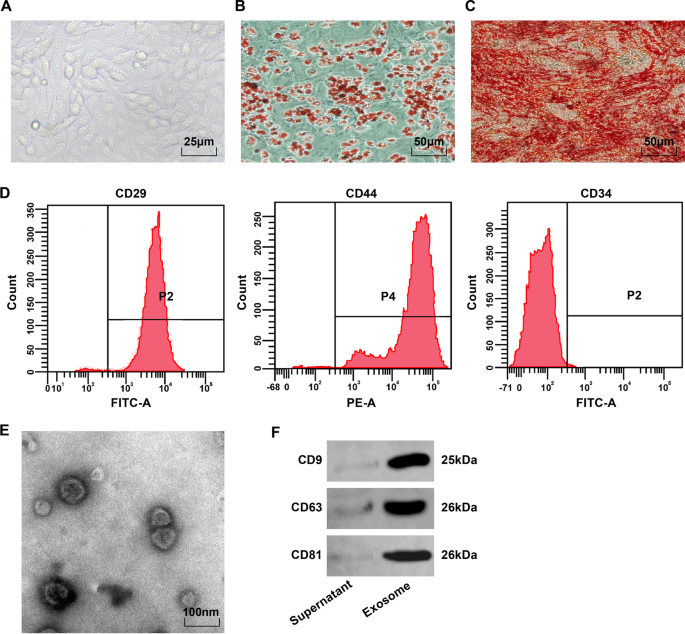
BMSC 表型观察和 BMSC-Exo 鉴定。 A 第4代BMSCs形态观察; B 脂肪细胞油红O染色结果; C 成骨细胞茜素红染色结果; D 通过流式细胞术检测 BMSC 的表型。 E BMSC-Exo的电子显微镜观察; F CD9、CD63、CD81蛋白条带
透射电镜观察到 BMSC-Exos 为椭圆形囊泡,外周膜结构清晰,大小不一,直径 40-100 nm(图 1E)。 Western印迹分析表明提取的产物表达外泌体来源的CD9、CD63和CD81特征蛋白(图1F)。
升高的外泌体 miR-133a 可改善心肌炎的症状
观察到用 miR-133a 重组腺病毒转染 BMSCs(图 2A)。倒置荧光显微镜下观察到大量NC、Ad-miR-133a和Adas-miR-133a的绿色荧光表达,表明重组腺病毒载体可有效转染BMSCs。为了测试 miR-133a 的转染效率,通过 RT-qPCR 测量了 BMSCs 及其外泌体中 miR-133a 的表达。发现miR-133a上调增加了miR-133a表达,而miR-133a下调降低了miR-133a表达(图2B)。随后,我们在大鼠体内注射了含有 miR-133a 的外泌体。倒置荧光显微镜下观察到NC Exo 治疗后VMC大鼠有绿色荧光表达 , Ad-miR-133a Exo , 或 Adas-miR-133a Exo ,表明重组腺病毒载体感染了大鼠的心肌组织(图2C)。 RT-qPCR实验还发现VMC大鼠miR-133a表达明显降低;注射Ad-miR-133a Exo 的VMC大鼠miR-133a表达明显升高 但在注射 Adas-miR-133a Exo 的 VMC 大鼠中减少 (图2D)。大鼠一般情况观察到正常对照大鼠一般情况正常,VMC特征在VMC大鼠和注射Adas-miR-133a Exo ,如头发粗糙杂乱、呼吸困难、饮食少等。在用 MSC Exo 治疗的 VMC 大鼠中 , NC 外置 , 和 Ad-miR-133a Exo ,这些迹象都得到了不同程度的改善。 VMC大鼠体重从感染后1天开始持续降低,注射MSC Exo , NC 外置 , 或 Ad-miR-133a Exo 增加了老鼠的体重。 Ad-miR-133a Exo 处理的VMC大鼠体重 Adas-miR-133a Exo 注射后VMC大鼠体重明显增加 明显减少(图2E)。
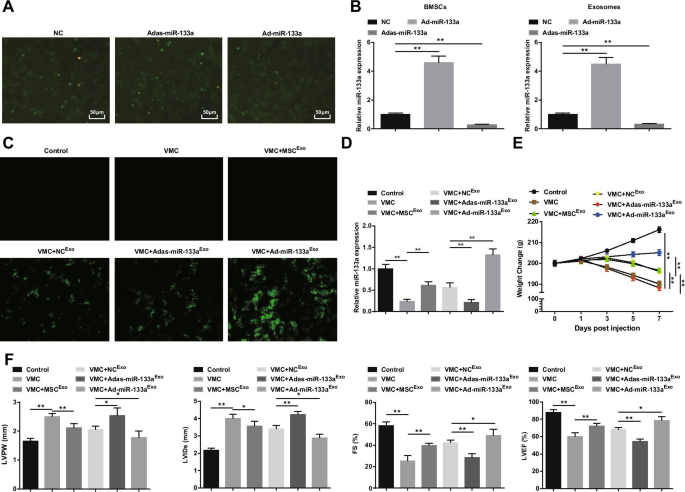
上调的外泌体 miR-133a 可减轻心肌炎。 A BMSCs转染miR-133a重组腺病毒; B RT-qPCR检测调控miR-133a后BMSCs及其外泌体中miR-133a的表达; C 倒置荧光显微镜检测miR-133a转染效率; D RT-qPCR检测心肌组织中miR-133a的相对表达量; E 各组大鼠体重变化; F 测定各组大鼠LVPW、LVIDs、FS和LVEF。 *P <0.05; **P <0.001
心肌功能观察表明(图2F),VMC大鼠的LVPW和LVIDs增加,FS和LVEF降低。注射外泌体后,VMC大鼠LVPW和LVIDs下降,FS和LVEF明显升高。 Adas-miR-133a Exo Ad-miR-133a Exo 治疗受损 改善VMC大鼠心肌功能。
上调的外泌体 miR-133a 抑制 VMC 大鼠心肌组织的炎症
HE染色显示正常对照大鼠心肌纤维排列紧密,间充质未见炎性细胞浸润。 VMC大鼠心肌细胞紊乱,间充质被大量炎性细胞浸润。注射MSC Exo 的VMC大鼠心肌细胞 或 NC Exo 排列有序,间质内有少量炎性细胞浸润。 Adas-miR-133a Exo 后VMC大鼠心肌细胞 治疗排列紊乱,间质内的炎性细胞浸润。 Ad-miR-133a Exo 处理VMC大鼠心肌细胞 排列有序,无明显炎症细胞浸润(图3A)。
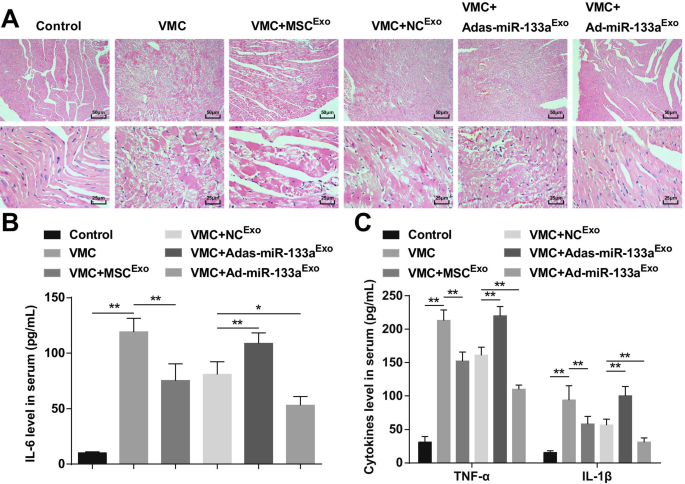
增加的外泌体 miR-133a 抑制了 VMC 心肌组织的炎症。 A 各组大鼠心肌组织HE染色; B ELISA检测血清中IL-6的表达; C ELISA检测血清中TNF-α和IL-1β的表达。 *P <0.05; **P <0.001
ELISA 表明(图 3B、C)炎症因子(TNF-α、IL-1β 和 IL-6)在 VMC 大鼠中明显增加。注射 Ad-miR-133a Exo 的 VMC 大鼠 炎症因子水平降低。 Adas-miR-133a Exo 治疗导致VMC大鼠炎症因子升高。
升高的外泌体 miR-133a 降低了 VMC 大鼠心肌组织的 CVF
Masson染色显示正常大鼠心肌纤维排列紧密,几乎没有蓝色胶原纤维。 CVB3注射后心肌细胞肥大,结缔组织增生,有大量蓝色胶原纤维,CVF明显升高。外泌体处理后,心肌细胞排列有序,细胞间结缔组织增生减少,蓝色胶原纤维和CVF明显减少。注射Adas-miR-133a Exo 的VMC大鼠心肌细胞间隙 增宽,细胞明显增大,蓝色胶原纤维和CVF明显增加; Ad-miR-133a Exo 的VMC大鼠细胞间隙减少,蓝色胶原纤维分布和CVF减少 处理(图4A、B)。
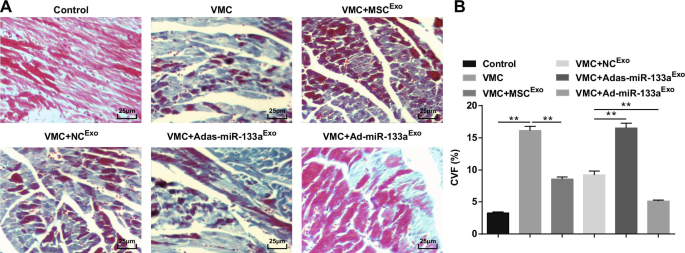
上调的外泌体 miR-133a 降低了 VMC 大鼠心肌组织中的 CVF。 A 大鼠心肌组织的 Masson 染色; B 各组大鼠胶原体积分数。 **P <0.001
外泌体 miR-133a 的增加降低了 VMC 大鼠心肌组织中胶原蛋白 I、胶原蛋白 III、TGF-β1 和 CTGF 的表达
胶原蛋白I和胶原蛋白III是胶原蛋白的主要成分,主要分布在细胞连接处和细胞膜、细胞间质和细胞质中。 TGF-β1 和 CTGF 是纤维化的标志蛋白。 RT-qPCR 的结果表明,VMC 大鼠的胶原蛋白 I、胶原蛋白 III、TGF-β1 和 CTGF mRNA 表达水平增加,但在外泌体处理后降低。 Ad-miR-133a Exo 处理的VMC大鼠 Adas-miR-133a Exo 后VMC大鼠的I型胶原、III型胶原、TGF-β1和CTGF的mRNA表达水平降低 处理显示出相反的情况(图5A-C)。

升高的外泌体 miR-133a 降低了 VMC 大鼠心肌组织中胶原 I、胶原 III、TGF-β1 和 CTGF 的 mRNA 表达。 A RT-qPCR检测大鼠心肌组织中Collagen I mRNA的表达; B RT-qPCR检测大鼠心肌组织中Collagen III mRNA的表达; C RT-qPCR检测大鼠心肌组织中TGF-β1和CTGF mRNA的表达。 *P <0.05; **P <0.001
外泌体miR-133a上调抑制VMC大鼠心肌组织的心肌细胞凋亡
TUNEL染色显示凋亡心肌细胞呈棕黑色或棕黄色,核凝聚。 VMC大鼠的凋亡细胞数量增加,这将通过外泌体处理减弱。注射 Ad-miR-133a Exo 的 VMC 大鼠 凋亡细胞和注射 Adas-miR-133a Exo 的细胞数量减少 凋亡细胞数量增加(图6A,B)。
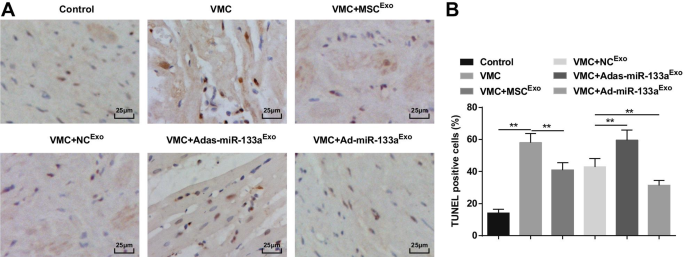
Increased exosomal miR-133a inhibits the cardiomyocyte apoptosis in myocardial tissues of rats with VMC. A TUNEL staining of rat myocardial tissues in each group; B The number of TUNEL positive cells in each group. **P <0.001
Elevated Exosomal miR-133a Depresses EMT in Myocardial Tissues of Rats with VMC
E-cadherin, α-SMA, and FSP-1 are key indicators of EMT. Results of RT-qPCR demonstrated that α-SMA and FSP-1 mRNA expression levels were elevated and E-cadherin mRNA expression level was decreased in VMC rats. In addition, α-SMA and FSP-1 mRNA expression levels were reduced and E-cadherin mRNA expression level was increased in VMC rats after exosome treatment. α-SMA and FSP-1 mRNA expression levels were elevated and E-cadherin mRNA expression level was decreased in VMC rats treated with Adas-miR-133a Exo , while the expression of these indicators was opposite in VMC rats injected with Ad-miR-133a Exo (Fig. 7A, B).
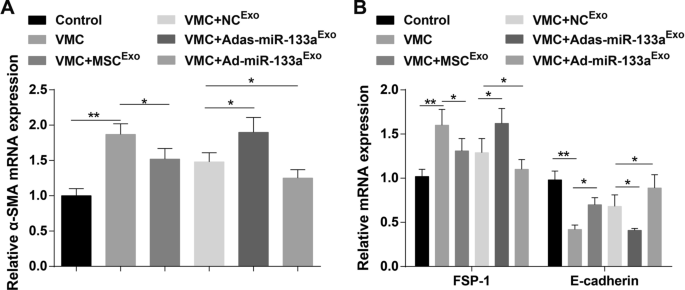
Up-regulated exosomal miR-133a represses EMT in myocardial tissues of rats with VMC. A The mRNA expression of α-SMA in rat myocardial tissues in each group was detected by RT-qPCR; B The mRNA expression of FSP-1 and E-cadherin in rat myocardial tissues in each group was detected by RT-qPCR. *P < 0.05; **P <0.001
Up-regulated Exosomal miR-133a Depresses Inflammation of Cardiomyocytes in VMC
As a result, fluorescence microscopy captured green fluorescent expression in VMC rats treated with NC Exo , Ad-miR-133a Exo , or Adas-miR-133a Exo , indicating that the recombinant adenovirus vector infected cardiomyocytes of rats (Fig. 8A). RT-qPCR and ELISA discovered that (Fig. 8B, D) miR-133a expression was reduced and inflammatory factors (TNF-α, IL-1β, and IL-6) were increased in VMC rats, which would be reversed by exosome treatment. The VMC rats treated with Ad-miR-133a Exo had up-regulated miR-133a and decreased inflammatory factors in VMC rats, while those treated with Adas-miR-133a Exo presented decreased miR-133a and increased levels of inflammatory factors in VMC rats.
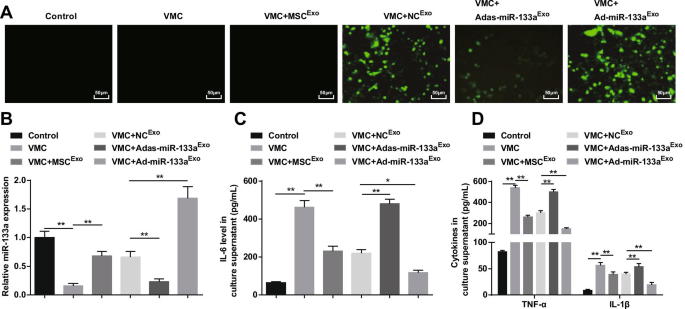
Elevated exosomal miR-133a restrains inflammation of cardiomyocytes in VMC. A miR-133a transfection efficiency tested via inverted fluorescence microscope; B The relative expression of miR-133a in cardiomyocytes of rats in each group; C IL-6 expression in culture supernatant of cardiomyocytes in each group; D TNF-α and IL-1β expression in culture supernatant of cardiomyocytes in each group. *P < 0.05; **P <0.001
Elevated Exosomal miR-133a Promotes Cell Viability, and Represses Apoptosis of Cardiomyocytes in VMC
The apoptosis and the cell viability were detected via AnnexinV-APC/PI double staining and CCK-8 assay. The results revealed that there was an obvious increase in apoptosis rate, a decrease in cell viability of cardiomyocytes in VMC rats. Exosome treatment reduced apoptosis rate and enhanced the viability of cardiomyocytes. Adas-miR-133a Exo enhanced the apoptosis rate and disrupted the viability of cardiomyocytes in VMC rats. Ad-miR-133a Exo treatment functioned the opposite effects on cardiomyocytes of VMC rats (Fig. 9A–C).
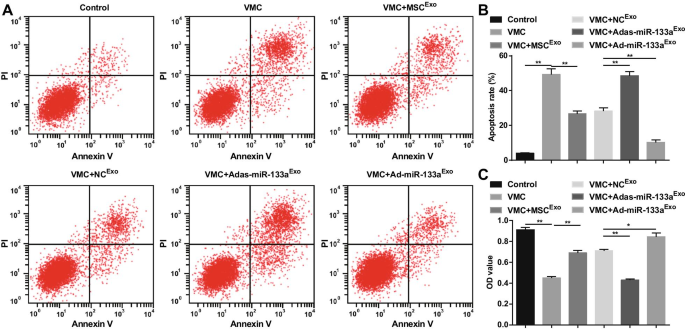
Increased exosomal miR-133a promotes viability and represses apoptosis in cardiomyocytes in VMC. A The cardiomyocytes apoptosis detected via flow cytometry; B Quantification results of A; C The cell viability detected via CCK-8 assay. *P < 0.05; **P <0.001
miR-133a Targets MAML1
It has been reported that up-regulated miRNA-193b reduces myocardial I/R damage by targeting MAML1 [18]. Based on that, we cross-screened downstream genes of miR-133a through bioinformatics websites PITA, miRanda, PicTar, microT and miRmap, and selected MAML1 as a target of miR-133a (Fig. 10A). We constructed MAML1-wt or MAML1-mut, and co-transfected cardiomyocytes with miR-133a mimic or NC. The results showed that miR-133a mimic reduced the luciferase activity of MAML1-wt (Fig. 10B). The RIP experiment further verified the targeting relationship between miR-133a and MAML1 (Fig. 10C). RT-qPCR and Western blot detection of MAML1 expression showed that MAML1 expression was decreased in cardiomyocytes transfected with miR-133a mimic (Fig. 10D, E).
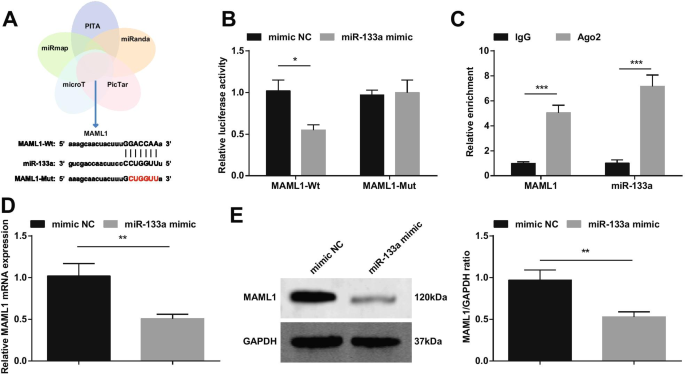
miR-133a targets MAML1. A miR-133a’s targets predicted on bioinformatics websites; B The targeting relationship between miR-133a and MAML1 verified by dual luciferase reporter gene experiment; C The targeting relationship between miR-133a and MAML1 verified by RIP experiment; D /E MAML1 expression changes after up-regulation of miR-133a detected by RT-qPCR and Western blot. *P < 0.05; **P < 0.01; ***P <0.001
Inhibition of MAML1 has a Protective Effect on Rats with Myocarditis and Reverses the Effect of miR-133a-Inhibited Exosomes on Rats with VMC
To further study the effect of miR-133a-regulated MAML1 on rats with VMC, we injected si-MAML1 or si-NC adenovirus into VMC rats or VMC rats that had been treated with miR-133a-silenced exosomes. The injection success was validated by RT-qPCR and Western blot (Fig. 11A, B). The results manifested that injection of si-MAML1, the weight of VMC rats was increased (Fig. 11C), cardiac function was improved (Fig. 11D–G), myocardial tissue pathology and fibrosis were attenuated (Fig. 12A–C), serum inflammation (Fig. 12D, E) and cardiomyocyte apoptosis (Fig. 13A–G) were inhibited. Also, the deleterious effects of miR-133a-silenced exosomes in VMC rats were reversed after injection of si-MAML1.
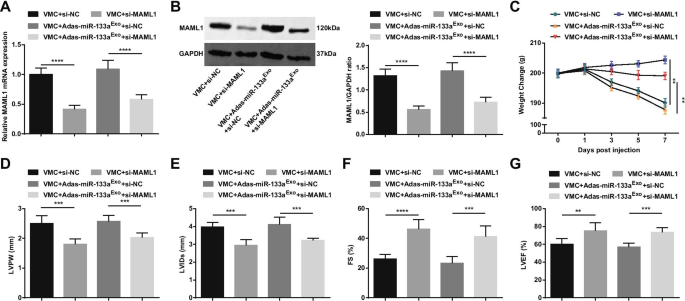
Inhibition of MAML1 has a protective effect on myocarditis rats and can reverse the effect of miR-133a-silenced exosomes on rats with VMC. A /B MAML1 expression in myocardial tissue of rats detected by RT-qPCR and Western blot; C. Weight change of rats; D –G Determination of LVPW, LVIDs, FS and LVEF in rats; **P < 0.01; ***P <0.001; ****P < 0.0001
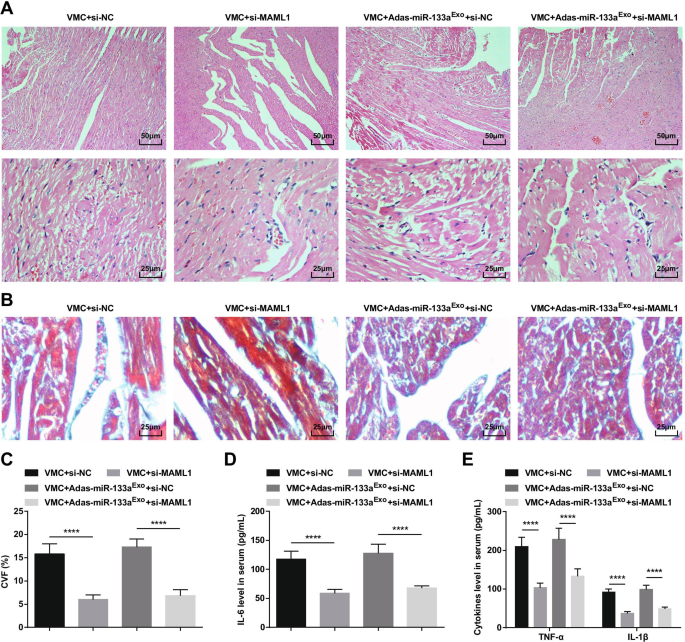
Inhibition of MAML1 can reverse the effect of miR-133a-silenced exosomes on rats with VMC. A HE staining of rat myocardial tissue; B Masson staining of myocardial tissues in rats; C CVF of rats; D The expression of IL-6 in serum tested via ELISA; E The expression of TNF-α and IL-1β in serum tested via ELISA.****P < 0.0001
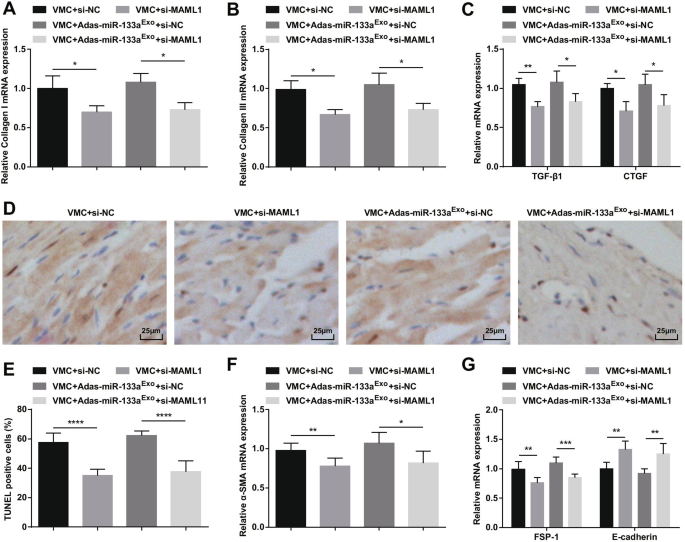
Inhibition of MAML1 can reverse the effect of miR-133a-inhibiting exosomes on rats with VMC. A Collagen I mRNA expression in myocardial tissues of rats was detected by RT-qPCR; B Collagen III mRNA expression in myocardial tissues of rats was detected by RT-qPCR; C TGF-β1 and CTGF mRNA expression in myocardial tissues of rats was detected by RT-qPCR; D TUNEL staining of rat myocardial tissues in each group; E The number of TUNEL positive cells in each group. F The mRNA expression of α-SMA in rat myocardial tissues in each group was detected by RT-qPCR; G The mRNA expression of FSP-1 and E-cadherin in rat myocardial tissues in each group was detected by RT-qPCR. *P < 0.05; **P < 0.01; ****P < 0.0001
Discussion
Myocarditis is an inflammatory heart illness resulting in DCM and heart failure and is most frequently induced by viral infections such as CVB3 [2]. A study has revealed that miR-133 relieves cardiomyocyte apoptosis and electrical remodeling in mice with VMC [23]. Additionally, changed exosomal miRNAs are also found to be linked with the pathogenesis of CVB3-induced myocarditis [14]. Exosomes derived from cardiac progenitor cells ease CVB3-induced apoptosis via restraining the proliferation of CVB3 in VMC [24]. This study explored the regulatory mechanism of BMSC-derived exosomal miR-133 on myocardial fibrosis and EMT in VMC rats (Additional file 1:Fig. 1).
The study found that the expression of miR-133a was decreased in VMC. As demonstrated before, miR-133a expression is decreased in MI [7]. A study has also suggested that the relative expression of miR-133 in mouse hearts of the VMC is obviously decreased with contrast to the controls [23]. There are some connections of miRNAs with exosomes. The differential expression of exosomes and of exosomal miRNAs in illness has been regarded as biomarkers of disease with performance of noninvasive clinical diagnosis together with their therapeutic potentials [25]. Lin et al. have found that miR-133 is specially sorted into hypoxia/reoxygenation (H/R)-caused human endothelial progenitor cells-derived exosomes to increase fibroblast angiogenesis and EMT [26]. Another study has revealed that MSCs exhibits a communication with brain parenchymal cells and may modulate neurite outgrowth by transfer of miR-133b to neural cells via exosomes [27].
The major finding of this work manifested that up-regulated exosomal miR-133a promoted cell viability, inhibited inflammation, apoptosis, EMT, and fibrosis in rats with VMC. They suits well with a former research that miR-133a silence reverses the Astragalus polysaccharides treatment-induced osteosarcoma MG63 cell proliferation inhibition, together with cell apoptosis promotion [28]. Another study has revealed that overexpressed miR-133a suppresses angiogenesis, apoptosis, fibrosis, and inflammation, while accelerating therapeutic cardiac remodeling in ischemic myocardial illnesses [29]. Similar to our study, Li et al. have stated that miR-133 inhibits cardiomyocyte apoptosis by regulating the expression of apoptosis-related genes in the hearts of VMC mice [23]. The over-expressed miR-133a has been reported to depress hypoxia-induced apoptosis and strengthen cardiomyocyte survival [30]. Meanwhile, the up-regulated serum exosomal miR-30a and miR-181d may have the potentials to be applied as biomarkers for VMC diagnosis [14].
Another finding in our study was that up-regulated exosomal miR-133a decreased CVF, reduced the expression of collagen I and collagen III in rats with VMC. A article has elucidated that released fibroblast growth factor-18 from a collagen membrane causes osteoblastic activity participating in down-regulated miR-133a [31]. In vitro excessive expression of miR-133a depresses cardiomyocyte hypertrophy and reduces collagen expression [32], as evidenced in another study. CVF equals the ratio of collagen area to the sum of myocardial area and collagen area, and the mean value shows the CVF of the section [33]. This finding is also reported by Wang et al. that VMC mice model is successfully constructed by CVB3 infection, manifesting apparent higher CVF expression in contrast with the control group [34]. Moreover, the finding is consistent with that of Ferreira et al. who demonstrates that miR-133a may take on a major role in the modulation of gene expression in chronic Chagas disease cardiomyopathy pathogenesis, with potential link as diagnostic and prognostic tools [8]. Furthermore, evidence has shown that knocking down MAML1 can reduce the hypertrophy of pre-treated cardiomyocytes [35]. In our study, we found that MAML1 was the target gene of miR-133a and inhibition of MAML1 reversed the effects of miR-133a-silenced exosomes on rats with VMC. In myocardial ischemia–reperfusion injury, miR-193b-mediated down-regulation of MAML1 could in part reduce infarction and myocardial enzymes, as well as attenuate apoptosis of cardiomyocytes [18]. Also, there is a report suggesting that deficiency of MAML1 could relieve hepatic fibrogenesis [19].
Conclusion
In conclusion, this present study offers evidence that miR-133a is down-regulated in rats with VMC, and elevated exosomal miR-133a improves cardiac function and restrains myocardial fibrosis and EMT in rats with VMC, as well as enhances viability and represses apoptosis of cardiomyocytes in VMC through targeting MAML1. Our study also suggests that inhibition of MAML1 has a protective effect on rats with myocarditis and reverses the effect of miR-133a-inhibited exosomes on rats with VMC. The identification of the exosomal miR-133a in myocardial fibrosis and EMT of myocarditis may potentially widen our understanding of mechanisms underpinning myocarditis and also bear clinical value as a novel molecular target. More researches should be undertaken for making inroads into the treatment of this disease.
缩写
- miR-133:
-
MicroRNA-133
- BMSC-Exo:
-
Bone marrow mesenchymal stem cell-derived exosome
- EMT:
-
Epithelial–mesenchymal transition
- VMC:
-
Viral myocarditis
- CVF:
-
Collagen volume fraction
- DCM:
-
Dilated cardiomyopathy
- CVB3:
-
Coxsackie B3 virus
- miRNAs:
-
MicroRNAs
- MI:
-
Myocardial infarction
- SPF:
-
Specific pathogen-free
- 标准差:
-
Sprague–Dawley
- DMEM:
-
Dulbecco’s Modified Eagle Medium
- PBS:
-
磷酸盐缓冲盐水
- FBS:
-
胎牛血清
- NC:
-
Negative control
- MOI:
-
Multiplicity of infection
- LVPW:
-
Left ventricular posterior wall thickness
- LVIDs:
-
Left ventricular end-systolic diameter
- LVEF:
-
Left ventricular ejection fraction
- 他:
-
苏木精-伊红
- TUNEL:
-
Terminal deoxynucleotidyl transferase-mediated deoxyuridine triphosphate-biotin nick end-labelin
- ELISA:
-
酶联免疫吸附试验
- TMB:
-
Tetramethylbenzidine
- TBS:
-
Tris-buffered saline
- ABC:
-
Avidin–Biotin-Peroxidase Complex
- OD:
-
Optical density
- RT-qPCR:
-
Reverse transcription quantitative polymerase chain reaction
- GAPDH:
-
Glyceraldehyde-3-phosphate dehydrogenase
- CTGF:
-
Connective tissue growth factor
- CCK:
-
Cell counting kit
- PI:
-
碘化丙啶
- ANOVA:
-
Analysis of variance
纳米材料
- 黑磷纳米颗粒通过上调 TG2 表达促进 EMSCs 的成骨分化
- 过渡金属掺杂高岭石纳米粘土的结构和电子特性
- 银纳米毛通过自组装和快速热退火“过度生长”活性炭纤维
- 通过原子力显微镜研究聚苯乙烯薄膜的附着力和玻璃化转变
- 关于双层/三层宽带 SiO2 抗反射膜横截面形貌的 TEM 和 STEM 研究
- 通过腹膜内和静脉内给药途径对大鼠生物合成铜和氧化锌纳米颗粒的体内比较检查
- 基于生物羟基磷灰石的含锶微晶玻璃复合材料的开发和表征
- 骨组织再生中的石墨烯家族材料:前景和挑战
- 基于原子力显微镜的软骨分化人类脂肪干细胞纳米显微镜:纳米结构和整合素 β1 表达
- 普鲁士蓝纳米颗粒标记的间充质干细胞:体外细胞活力、增殖、迁移、分化、细胞骨架和蛋白质表达的评估
- 由过渡元素 V、Cr 和 Mn 边缘改性的扶手椅黑色磷烯纳米带的电子特性
- 多铁性 ABO3 过渡金属氧化物:铁电性和磁性的罕见相互作用


